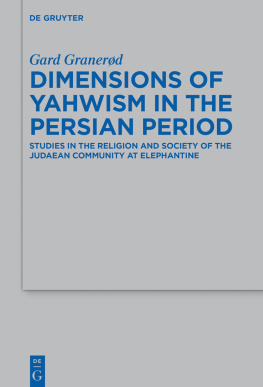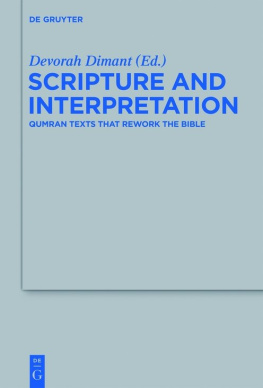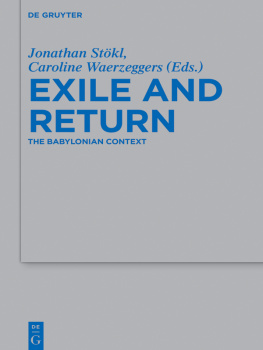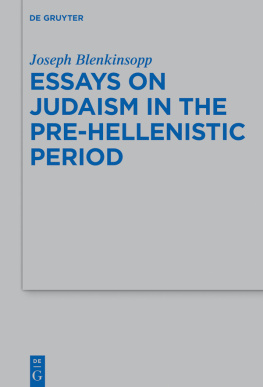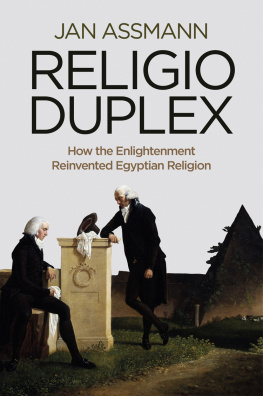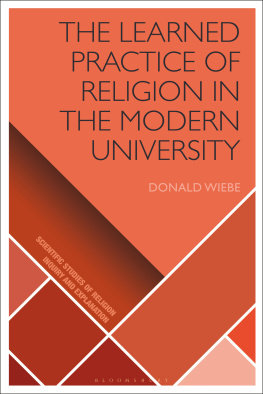DIMENSION OF YAHWISM IN THE PERSIAN PERIOD
Guide

Gard Granerd
Dimensions of Yahwism in the Persian Period
Beihefte zur Zeitschrift fr die alttestamentliche Wissenschaft

Edited by
John Barton, Reinhard G. Kratz, and Markus Witte
Volume 488

ISBN 978-3-11-045211-2
e-ISBN (PDF) 978-3-11-045431-4
e-ISBN (EPUB) 978-3-11-045317-1
ISSN 0934-2575
Library of Congress Cataloging-in-Publication Data
A CIP catalog record for this book has been applied for at the Library of Congress.
Bibliographic information published by the Deutsche Nationalbibliothek
The Deutsche Nationalbibliothek lists this publication in the Deutsche Nationalbibliografie;
detailed bibliographic data are available on the Internet at http://dnb.dnb.de.
2016 Walter de Gruyter GmbH, Berlin/Boston
Typesetting: Konrad Triltsch, Print und digitale Medien GmbH, Ochsenfurt
www.degruyter.com

To Prof. Dr Karl William Weyde in gratitude

These people worship God the overseer and creator of all, whom all men worship including ourselves, O King, except that we have a different name. Their name for him is Zeus and Jove. ( Letter of Aristeas )
Preface
This book is a child that was conceived when I started my postdoctoral research at MF Norwegian School of Theology in August 2010. The idea was to write a monograph about the religion of the Judaeans at Elephantine. My working title was The Temple of YHW, the God Dwelling in Elephantine: The Non-Biblical Judaism on the Nile Island of Elephantine in the Fifth Century BCE as a Challenge for Biblical Theology . Now, I have been delivered of the child, which indeed turned out to be a monograph. Throughout the pregnancy, the focus continued to be on the Judaean community at Elephantine in the Achaemenid period. However, as the time lapsed, I found myself emphasising the religio-historical aspects at the cost of the original biblical-theological interest. Therefore, the alternative title jokingly suggested by the PhD student Matthew P. Monger The Elephant in the Room: Persian Period Yahwism and the Judaean Community at Elephantine does indeed capture some important aspects of the present book. In this volume I do not present any hitherto unknown ancient documents. Instead, what I do offer is a fresh investigation of the so-called Elephantine documents and other relevant sources, working primarily on the basis of texts that already have been published, and focussing particularly on religio-historical questions. I hope to demonstrate that the Yahwism practiced in Elephantine represents a fully-fledged example of Persian-period Judaean religion. In the Persian period, Yahwism had several dimensions, and the historically best-attested one is reflected in the documents from Elephantine. Therefore, my Bible is above all the text edition of Bezalel Porten and Ada Yardeni, Textbook of Aramaic Documents from Ancient Egypt , vols. IIV (Jerusalem: The Hebrew University of Jerusalem Department of the History of the Jewish People, 19861999), from which I have also taken the text numbering systemeven when I quote translations offered in other text editions than that of Porten and Yardeni, or in a few cases present my own translations. Thus, e. g., A4.1:13 refers to Porten and Yardeni, Textbook of Aramaic Documents from Ancient Egypt , vol. I, section 4 (which in fact is the so-called Jedaniah communal archive), text no. 1, lines 13.
In the preface to In the Shadow of the Temple: Jewish Influences on Early Christianity (Downers Grove, IL: InterVarsity Press, 2002), my professor of church history, Prof. Dr Oskar Skarsaune, wrote words I would like to make my own:
Most authors feel the need for serious disclaimers with regard to books as comprehensive as this one: it simply must contain mistakes of fact, judgement and method. It certainly does. But it lies in the very nature of historical inquiry that results are always preliminary and open to revision and improvement. I would very much like to think of a book like this as my contribution to an open-ended conversation going on in the enlightened community of readers.
Others will have to decide to what extent I have succeeded in making this book a fruitful contribution to the ongoing conversation about Persian-period Yahwism and Elephantine. Nevertheless, I am grateful to my wonderful wife, Antone Varhaug Granerd, and our children, Eira, Ansgar and Berge, for supporting (and tolerating) a husband and father who has been pregnant with a book for five years, and who spent the last months of writing it with a DAAD scholarship in Gttingenleaving the family behind. Moreover, I am grateful to my parents, Grete and Vidar Granerd, for offering our children a second home whenever Antone and I were busy working.
I am grateful to Dr Duncan Burns of Forthcoming Publications for proofreading and copyediting the manuscript and for preparing the indices. I am also grateful to my alma mater , MF Norwegian School of Theology, for having shown confidence in me, and to its librarians for their excellent assistance. Moreover, I wish to record the gratitude I feel towards a number of colleagues and research networks: OTSEM, for having given me the opportunity to present papers when I was a postdoc; Prof. John Ma (Oxford) and Prof. Christopher Tuplin (Liverpool), for including me in the project Communication, Language and Power in the Achaemenid Empire: The Correspondence of the Satrap Arshama; and Hekhal The Irish Society for the Study of the Ancient Near East, for hosting conferences at which I was able to present some of my ideas. Furthermore, I am thankful to Dr Martin Hallaschka (Hamburg) for his useful responses to an early draft of , The Ethical Dimension. My thanks also go to Prof. Dr Reinhard G. Kratz, who gave useful responses at several stages in the writing process. My colleague Prof. Dr Liv Ingeborg Lied gave useful feedback when this work was in its early stages. Furthermore, my colleagues in the Department of Hebrew Bible/ Old Testament studies have provided a fine environment for a number of minor and major discussions: the PhD students Ingunn Aadland, Matthew Philip Monger, Hkon Sunde Pedersen (also Asst. Prof., Fjellhaug International University College), Hans-Olav Mrk (The Norwegian Bible Society), Asst Prof. Andrew Wergeland, Prof. Dr Kristin Joachimsen, Prof. Dr Corinna Krting (now University of Hamburg), andlast but not leastProf. Dr Karl William Weyde. Throughout the entire writing process Prof. Weyde has been mentor, critical reader, and cheer leader (although I suspect that he doesnt agree with everything in this book!). I do not exaggerate when I say that I would not have been able to bring this project to completion without his generous support. Therefore, it is an honour to dedicate this book to Prof. Weyde: teacher, Doktorvater , colleague and friend.

